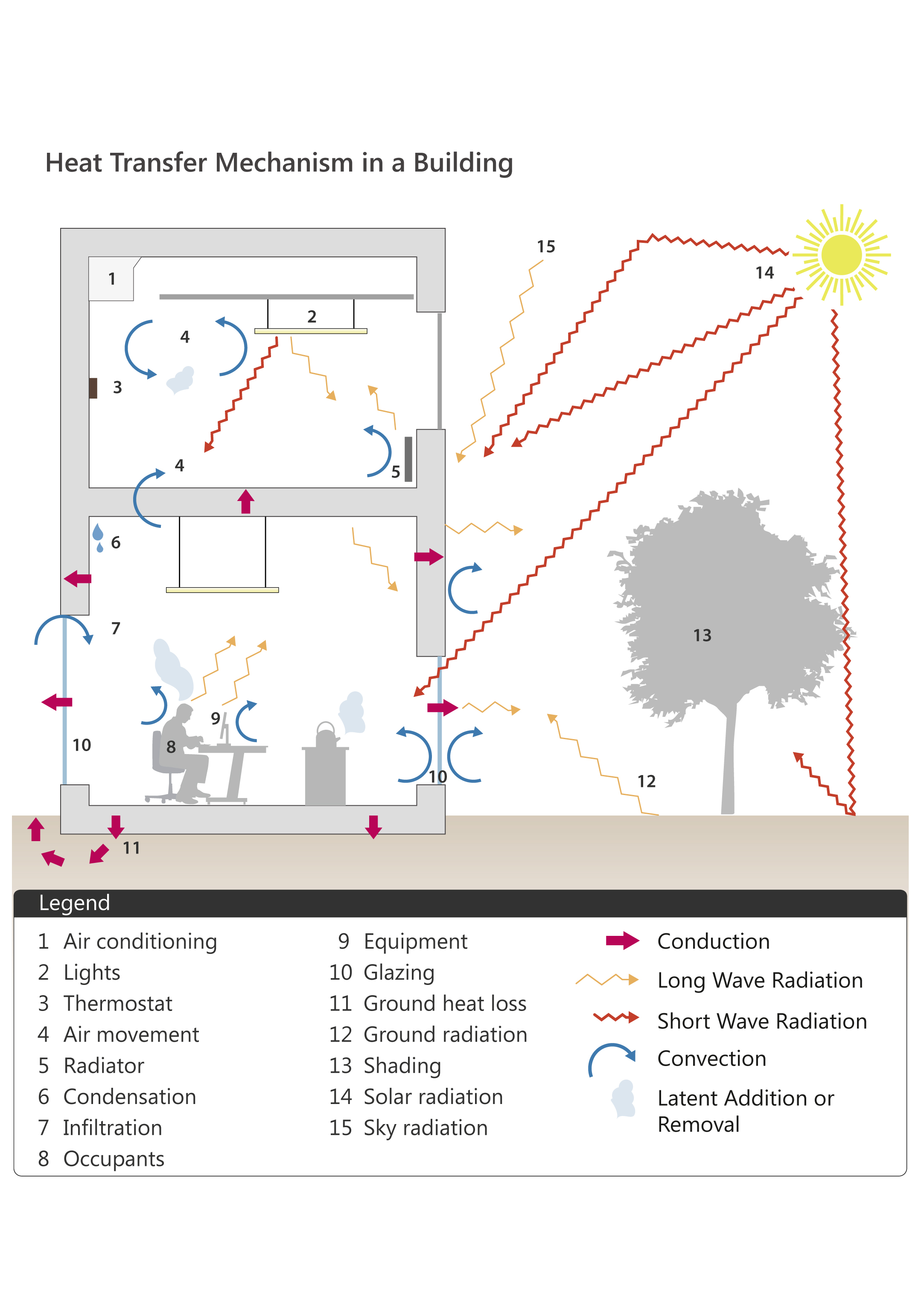-
Notifications
You must be signed in to change notification settings - Fork 1
What is TAS?
Tas by EDSL (https://www.edsl.net/) is a software tool which simulates the thermal performance of buildings. The main applications of the program are in assessment of environmental performance, prediction of energy consumption, plant sizing, analysis of energy conservation options and energy targeting. Detail Theory documentation can be downloaded here. Here you can find Technical Brief or validation.
The fundamental approach adopted by Tas is dynamic simulation. This technique traces the thermal state of the building through a series of hourly snapshots, providing the user with a detailed picture of the way the building will perform, not only under extreme design conditions, but throughout a typical year. This approach allows the influences of the numerous thermal processes occurring in the building, their timing, location and interaction, to be properly accounted for.
These processes are illustrated schematically in Figure 1 which shows the movement of heat in various forms as it is conveyed into, out of and around the building by a variety of heat transfer mechanisms.

Figure 1
Conduction in the fabric of the building is treated dynamically using a method derived from the ASHRAE response factor technique. This efficient computational procedure calculates conductive heat flows at the surfaces of walls and other building elements as functions of the temperature histories at those surfaces. Constructions of up to 12 layers may be treated, where each layer may be composed of an opaque material (e.g. brick), a transparent material (e.g. glass) or a gas (e.g. air). Databases of materials and constructions are available.
Convection at building surfaces is treated using a combination of empirical and theoretical relationships relating convective heat flow to temperature difference, surface orientation, and, in the case of external convection, wind speed.
Long-wave radiation exchange is modelled using the Stefan-Boltzmann law, using surface emissivities from the materials database. Long-wave radiation from the sky and the ground is treated using empirical relationships.
Solar radiation absorbed, reflected and transmitted by each element of the building is computed from solar data on the weather file. The calculation entails resolving the radiation into direct and diffuse components and calculating the incident fluxes using a knowledge of sun position and empirical models of sky radiation. Absorption, reflection and transmission is then computed from the thermophysical properties of the building elements. External shading and the tracking of sun patches around room surfaces may be included at the user’s option.
Internal Conditions, which include room gains from lights, equipment and occupants as well as infiltration rates and plant operation specifications are grouped together in profiles which are applied to the various zones of the building. Internal Conditions profiles may be stored in a database for later retrieval. Gains are modelled by resolving them into radiant and convective portions. The convective portion is injected into the zone air, whilst the radiant gains are distributed amongst the zone’s surfaces.
Infiltration, ventilation and air movement between the various zones of the building causes a transfer of heat between the appropriate air masses which is represented by terms involving the mass flow, the temperature difference and the heat capacity of air.
Solar radiation entering a zone through transparent building components falls on internal surfaces, where it may be absorbed, reflected or transmitted depending on the surfaces’ properties. Distribution of reflected and transmitted solar radiation continues until all the radiation has been accounted for.
Heating and cooling plant is represented by plant capacities, setpoints and control bands. Like gains, plant inputs may have both radiant and convective portions.
Tas solves the sensible heat balance for a zone by setting up equations representing the individual energy balances for the air and each of the surrounding surfaces. These equations are then combined with further equations representing the energy balances at the external surfaces, and the whole equation set is solved simultaneously to generate air temperatures, surface temperatures and room loads. This procedure is repeated for each hour of the simulation.
A latent balance is also performed for each zone which takes account of latent gains, moisture transfer by air movement and the operation of humidification and dehumidification plant.
The following are some of the factors which influence the thermal behaviour of a building and whose influences Tas allows the user to investigate:
• Thermal insulation • Thermal capacity ("thermal mass") • Glazing properties • Built form and orientation • Climate • Shading from nearby buildings and self-shading • Infiltration • Natural ventilation • Mechanical ventilation • Solar gain • Gains from lights, occupants and equipment (both sensible and latent) • Control setpoints & bands, optimum start, frost protection • Available plant capacities for heating and cooling • Plant schedules • Plant radiant/convective characteristics • Performance of boilers and heat pumps
Tas provides output in graphical and tabular form showing the effects of these factors on:
• Air temperature • Mean radiant temperature • Resultant temperature • Surface temperatures • Humidity • Condensation risk • Sensible and latent loads • Energy consumption • Required plant size